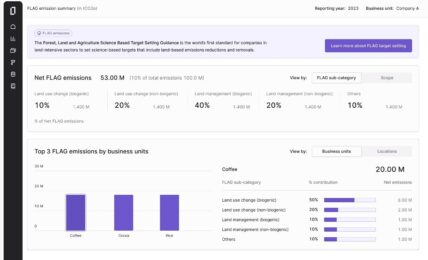A comprehensive review by the European Central Bank (ECB) into the management of climate and environmentalEnvironmental criteria consider how a company performs as a steward of nature. More (C&E) risks by the European banking sector uncovered major shortfalls in preparedness, with no banks meeting expectations, and many lacking plans to improve sufficiently.
The report follows the publication last year by the ECB of it Guide on C&E Risks, which set out a series of expectations for banks regarding the integration of C&E risks into their business models and strategies, governanceGovernance deals with a company’s leadership, executive pay, audits, internal controls, and shareholder rights. More and risk appetite. The new assessment includes the results from the follow-up benchmarking exercise into the bank’s preparedness to manage and disclose CE& risk. The assessment covered 112 banks under ECB supervision, representing €24 trillion of combined assets.
One of the key findings of the review was a variation between banks on the awareness of their exposure to climate and environmentalEnvironmental criteria consider how a company performs as a steward of nature. More risks. While half of the banks reviewed expect a material risk profile impact from C&E risk over the next five years, the report found a significant shortfall in risk assessment by all banks that said they were not exposed to C&E risk.
In a blog post discussing the report’s findings, Frank Elderson, Member of the Executive Board and Vice-Chair of the Supervisory Board of the ECB, said:
“Tellingly, of the institutions that report C&E risks as being immaterial to them, not a single one has an appropriate materiality assessment in place: they are either not comprehensive enough in their risk assessment or they haven’t even attempted to analyse the impacts of climate risk on their business at all.”
While the assessment indicated that banks have generally made efforts on ECB expectations in areas such as management bodies, risk appetite and operational risk management, none of the banks are close to meeting expectations, with many particularly lagging on internal reporting, market and liquidity risk management, and stress testing. The ECB found that half of the banks do not have substantial plans to integrate climate and environmentalEnvironmental criteria consider how a company performs as a steward of nature. More risks into their business strategies, and more than 80% have failed to develop key risk indicators to monitor.
One of the few areas that have seen meaningful progress to date is the integration of climate risk into credit risk management, with the implementation by several banks of enhanced due diligence procedures or actions to limit financing of activities with high climate risk exposure.
Elderson wrote:
“We are aware of the challenges linked to integrating C&E risks into banks’ strategies, governanceGovernance deals with a company’s leadership, executive pay, audits, internal controls, and shareholder rights. More and risk management arrangements. Today’s report will help banks to overcome those challenges. Moreover, financial institutions have more and more data and information available that they can use in designing strategies to concretely measure and manage their current and future exposures to C&E risks. The time is now ripe for banks to take comprehensive and forward-looking action on climate-related and environmentalEnvironmental criteria consider how a company performs as a steward of nature. More risks. The message of today’s report is clear: the time for action is now.”
Following the assessment, the ECB said that it will conduct a full review in the first half of 2022 of banks’ preparedness to manage climate and environmentalEnvironmental criteria consider how a company performs as a steward of nature. More risk, including deep dives into the incorporation of C&E risk into strategy, governanceGovernance deals with a company’s leadership, executive pay, audits, internal controls, and shareholder rights. More and risk management.
The ECB also plans to publish its findings on banks’ climate and environmentalEnvironmental criteria consider how a company performs as a steward of nature. More risk disclosures in the first quarter of 2022.
Click here to view the full ECB report.
The post ECB Says Every Bank Reviewed Falls Short on Managing Climate and Environmental Risk appeared first on ESG Today.


